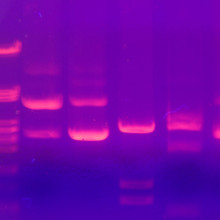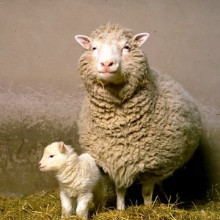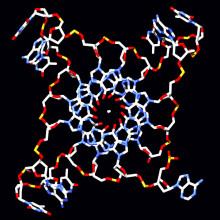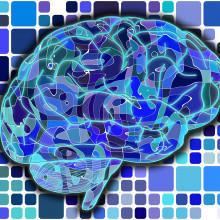New Zealand adventures with sheep, finding the Huntington's gene, developing new therapies for the brain and unravelling its complexities.
In this episode

00:00 - Taking a trip to New Zealand
Taking a trip to New Zealand
with Hannah Critchlow, Cambridge University
transcript to follow.....

06:40 - Hollywood steps in
Hollywood steps in
with Associate Professor Lynette Tippett, Professor Russell Snell, Auckland University
Richard mentioned a single gene responsible for Huntington's with a genetic test available to diagnose people. No other disorder of the brain has made this breakthrough and I wanted to find out more about how this gene was discovered.
Russell - Hi. My name is Professor Russell Snell and I'm in the School of Biological Sciences in the University of Auckland. I was one of the members of the group that found the gene actually, now 20 years ago. I have to say that the Huntington's disease research community is a little bit special because it's always had lots of input and interaction with people or families who were affected by the disease. And so, there's always quite a reality about our research meetings because generally speaking, somebody from and Huntington's family or a Huntington's patient who comes along to the meeting and presents in some way that is rather galvanising. It's great, so it's true partnership between the research community and patients, which is at it should be. Many years ago, when we found the gene, that was a collaborative group and great collaboration where we all shared the data prior to publication and see how rapidly, through collaboration research can advance.
Hannah - We'll find out more about the gene and how sheep are involved in  studying it shortly. But first, associate professor of psychology Lynette Tippett from Auckland University expands on how the Huntington's disease research community came about.
studying it shortly. But first, associate professor of psychology Lynette Tippett from Auckland University expands on how the Huntington's disease research community came about.
Lynette - It began really with Milton Wexler, a psychiatrist in Hollywood. His wife died of Huntington's disease, as did his 3 brothers. He had 2 daughters who are still alive today, Nancy and Alice Wexler. He decided he needed to find this gene and find a cure for Huntington's disease that he could cure his family or save his family. And so, what he did was he started pulling together scientists from all around and just sort of putting them in a room and making them brainstorm finding this gene and finding out how to cure Huntington's disease. It was unusual because instead of people fighting for grants and all the competitiveness that goes on in a lot of science, he managed to get these scientists in room, get them all in the same page, and all just being open and brainstorming ideas. That's really how the Huntington's research field began. So, the gene was finally found in 1993. So, that's 20 years ago. That sort of legacy of a lot of collaborative and interactive and international groups working together, that legacy of that collaboration I think continues today. I think it's down to that very unique start to focus Huntington's research that came from the efforts of Milton Wexler.

09:54 - Identifying the Huntington's Gene
Identifying the Huntington's Gene
with Professor Russell Snell, Auckland University
Hannah - Back to Russell to find out how this collaboration resulted in the successful identification of the gene involved in Huntington's disease.
Russell - Again, it was a partnership between researchers and the families. It was looking at families and looking at people - if you can imagine - like an upside down tree where the gene is inherited down the family. We can follow the inheritance of that particular piece of DNA in a family and look at individuals that got it and individuals that didn't. In doing it was molecular tools or DNA tools, we can narrow the region down until we narrowed it down to a single point. They found an absolutely convicting mutation or variation in the gene which is like a lengthening of a piece of DNA in a particular tract in the gene.
was looking at families and looking at people - if you can imagine - like an upside down tree where the gene is inherited down the family. We can follow the inheritance of that particular piece of DNA in a family and look at individuals that got it and individuals that didn't. In doing it was molecular tools or DNA tools, we can narrow the region down until we narrowed it down to a single point. They found an absolutely convicting mutation or variation in the gene which is like a lengthening of a piece of DNA in a particular tract in the gene.
Hannah - So, that lengthening of that one section of DNA was being passed three generations and those individuals that we affected in generations then developed these symptoms of Huntington's and that's how you identified the genetic basis of Huntington's?
Russell - Yes, absolutely and there was one other piece of information that came along with it that really nailed it. It was that on average, if you inherited a longer repeat or the sort of tract, you can imagine that as like a bicycle chain that gets longer, where on average, when the repeat is longer because it varies between all of us, including people who don't get Huntington's disease. If the repeat is longer, then the age of onset is lower. So, you can draw a curve. If you're unfortunate enough to inherit a very long repeat, say, over 60 or 70 units, then the age of onset tends to be younger than 20. Again, there's a lot of variability with what convicted this gene is, the gene that causes Huntington's disease.
Hannah - And going back to the analogy of the bicycle chain, so the longer the bicycle chain, the less far you're probably able to ride before actually the chain slips off, you can't ride anymore.
Russell - That's probably where the analogy breaks down a little bit because Huntington's disease is a disease caused by - it's called a dominant disease. It means that you only need inherit one copy of the expanded repeat. There's still debate about whether it contributes a gain of bad function or a loss of good function. The debate I think is falling on the side and this is what I believe as well, that there is a gain of dysfunction. So, almost like one is inheriting something that takes on a brand new part bad function for the cells in the brain.
Hannah - What does this gene usually do in the brain when it's the right length?
Russell - We don't really know. Even after 20 years, we know that it's absolutely required for embryo development. So, if you remove the gene in mice and they don't develop past day 7. We know that it's very likely to be involved in transport in axons. That's the nerves in the brain, so transport of molecules up and along these very long sticky outy branches in the brain. We also suspect it's involved in metabolism of the brain, so the feeding of the brain with glucose. Huntington's patients lose weight dramatically towards the end and on average, over life, they're slightly lighter. There appears to be some sort of metabolic deficit and I kind of favour this. I quite like this theory that in some way, for some reason we don't know, the feeding of these neurons in the brain, the supply of glucose to neurons in the brain is not operating that well. So, this is just another theory, but maybe these cells are being starved of food. But beyond that, we really don't know and I think the reason for that is because it's involved in so many things.
Hannah - Which is why you get this myriad of symptoms with the patients that have got this expansion of this gene?
Russell - I think the range in symptoms and the range of how the disease progresses or proceeds and the age that it presents is to do with, at least in part, how we are able to cope with the gain of dysfunction. I think some people are better able to cope with that because of what they inherited in their environment. Other people are least able to cope with it. A word that's quite often used is plasticity which is kind of a cool word and that it kind of means that how plastic, how malleable your brain is to cope with this terrible insult that happens. We know that some people can because there's quite a bit of cell loss in Huntington's disease in most cases that people can cope with different amounts of cell loss before the symptoms come on. It's quite remarkable. The brain is quite a remarkable thing.

15:28 - Scientists studying sheep?
Scientists studying sheep?
with Professor Russell Snell, Auckland University
Hannah - Scientists are studying this remarkable brain, this remarkable gene and how it's involved in leading to Huntington's with these expansions of the CAG repeats in quite unusual and remarkable animals......
Russell - Yeah, why sheep? I grew up in a farm in New Zealand. Sheep are  docile, but also intelligent. They've got big brains. I could see models wondering around a paddock, eating grass and living an ordinary sheep life until we wanted to look at their brains. And so, it seemed to me, at least for these slight onset neurodegenerative diseases or Huntington's disease, is that we could make an ethical model where they live a normal sheep life until they don't, if that makes sense. So, that is just the ethical line that I draw. We knew something about the sheep brain structure and actually how to manage them in a farming situation. We're good at looking after sheep. We're good at understanding sheep. So, it's a combination of things. The sheep genome or the sheep gene is a little bit closer to human. Also, we knew that we could do behavioural things for sheep because sheep have behaviours or we imagine we could but Jenny has really taken it to a major different level. Well, she's done an incredible job there.
docile, but also intelligent. They've got big brains. I could see models wondering around a paddock, eating grass and living an ordinary sheep life until we wanted to look at their brains. And so, it seemed to me, at least for these slight onset neurodegenerative diseases or Huntington's disease, is that we could make an ethical model where they live a normal sheep life until they don't, if that makes sense. So, that is just the ethical line that I draw. We knew something about the sheep brain structure and actually how to manage them in a farming situation. We're good at looking after sheep. We're good at understanding sheep. So, it's a combination of things. The sheep genome or the sheep gene is a little bit closer to human. Also, we knew that we could do behavioural things for sheep because sheep have behaviours or we imagine we could but Jenny has really taken it to a major different level. Well, she's done an incredible job there.

16:59 - How intelligent are sheep?
How intelligent are sheep?
with Professor Jenny Morton, Cambridge University
Hannah - I wanted to find out more about these sheep and how they behave, so I met up with Jenny Morton, from the University of Cambridge.
Jenny - Sheep in a flock have a poor reputation. They follow each other, they do daft things if one sheep get stuck in a fence, another sheep will get stuck in a fence, and they also look a bit silly. But I always liken them to teenagers. Teenagers in a group don't always behave perfectly, but you get a teenager by themselves, and they're usually really quite civilised. It's the same with sheep. Sheep in a flock can be very silly. You get a sheep by itself working under controlled conditions. They perform very well. They're very intelligent, a little bit moody, but they understand things. They learn very quickly.
Hannah - So, the kind of experimental tests that you do...
Jenny - We're trying to design experiments that will test cognitive function in decision making in particular. Sheep can do tasks where the rule changes and they can figure out that there is a new rule and what the new rule is and perform accordingly.
Hannah - So for example, if I go down a corridor, I know at the left hand side, there's going to be a little treat for me, a little chocolate bar. And so, I keep going down the left hand side and then suddenly, you might switch that treat to the right hand side corridor and then I'll learn to get on to the right instead of the left. That's the kind of thing you do with your sheep?
Jenny - Yeah, that's almost exactly what we do, except we use coloured buckets. So, we'll say, "If you go to the yellow bucket, there will be a reward. If you go to the blue bucket, there won't be a reward." So, the sheep learn very quickly to go to the yellow and then you can switch colours so you can suddenly present them with a new pair of colours and they have to make a new decision. First, they have to go, "Oh, that's just the colour bucket test. I'll choose one of them and then I can learn what the new role of these new colours is." What we now do though is we actually use computer screens. So, we don't need to have buckets and they don't have to walk in. They actually just use computer screens and choose symbols off of a computer screen.
Hannah - And this type of decision making, it's important isn't it in everyday human life and as we're hearing, it can be affected in Huntington's disease?
Jenny - It's absolutely critical. In fact, that's why I started with two choice discrimination tasks because Huntington's patients can learn to do these sort of tasks that they have trouble with these sort of reversals that you were talking about. So, they learn something, but then when the rule changes, they perseverate on the old rule. So, they'll stick to the same thing they knew and they have great difficulty with flexible thinking. That's why I chose to develop that task for the sheep.
Hannah - I've heard that you've even managed to get some of your sheep playing games of football with proper goal posts and the sheep counting the goals as well. Are they able to know who's the victorious team?
Jenny - The sheep don't play football with each other but I did teach sheep how to kick a ball into a goal because again, I'm looking for tasks of skill and motor coordination. I also wanted something that sheep didn't normally do. Now, sheep don't normally kick a football. If they see a football on the field, they would be afraid of it because it was weird. But I taught the sheep how to kick a football because I know that it's a good test of balance, coordination, and skill that might be useful for testing balance coordination and skill in the HD sheep.
Hannah - Thanks to Professor Jenny Morton from Cambridge University.

20:33 - A new treatment for Huntington's?
A new treatment for Huntington's?
with Professor Russell Snell, Auckland University
Russell and colleagues developed a Huntington's disease flock of transgenic sheep that he's called the Kiwis. They've been genetically tweaked to contain a short number of CAG genetic repeats. Looking at their brains, they show the same pathology as very early stage Huntington's. Russell is using the kiwi model to help find out how to safely stop full Huntington's progressing by preventing the bad Huntington's protein from accumulating in the brain as he explains..
Russell - So, the central dogma of molecular biology is that a gene in the  genome is read and it is read and copied into the stuff called RNA or messenger RNA and then that's get read and copied into protein. If we could remove the messenger RNA, then the message won't go forward and be translated into a protein. Actually, that is the language we use. If you make small molecules of RNA that could stick the copy carrying the mutation, then the cell has this wonderful mechanism of recognising when two RNA molecules are stuck together and comes along with an enzyme called dicer. It nibbles it and chops it up and then it's removed. So, if we can get those small RNA molecules into the brain and they're going to do that by injecting a virus. If that virus gets taken up by the vulnerable cells, expressing or producing these small molecules which will stick very specifically to the aberrant or mutant RNA and just chop it up.
genome is read and it is read and copied into the stuff called RNA or messenger RNA and then that's get read and copied into protein. If we could remove the messenger RNA, then the message won't go forward and be translated into a protein. Actually, that is the language we use. If you make small molecules of RNA that could stick the copy carrying the mutation, then the cell has this wonderful mechanism of recognising when two RNA molecules are stuck together and comes along with an enzyme called dicer. It nibbles it and chops it up and then it's removed. So, if we can get those small RNA molecules into the brain and they're going to do that by injecting a virus. If that virus gets taken up by the vulnerable cells, expressing or producing these small molecules which will stick very specifically to the aberrant or mutant RNA and just chop it up.
Hannah - Russell Snell, describing a new therapy, hoping to prevent Huntington's. Exciting studies and the results are expected in the middle of 2014.

22:33 - How mice are helping with Huntington's
How mice are helping with Huntington's
with Dr Alisa McGregor, Auckland University
Mice are also being used to study Huntington's. This time though, by accelerating the disease. I spoke with Dr. Ailsa McGregor, also at Auckland University.
Ailsa - So, our mice have also an increased CAG repeat lengths, but it's 120  repeats. So, it's much, much more than you would see in a human patient because we need an accelerated pathology in the animals to fit with the lifespan of a mouse.
repeats. So, it's much, much more than you would see in a human patient because we need an accelerated pathology in the animals to fit with the lifespan of a mouse.
Hannah - So, what are you seeing this mega long CAG repeats of this Huntington gene?
Ailsa - So, we see this really classical motor impairments that human patients see. We also see very early cognitive problems. So, these mice are not able to learn how to do the motor test that we usually use to assess coordination in these animals. They also really have a lot of problems with what we call delayed dependent memory. So, can you remember this one piece of information in 5 minutes time or in a day's time? They also are very poor in recognition memory. So, recognizing that there is a new object in their environment. We also look at psychiatric impairments in these animals which are much more difficult to measure, but we have ways that we can assess that type of behaviour in animal models and our transgenic mice also show a depressive like behaviour from about 6 months of age. There is a very specific way that we look at depression in mice because they obviously can't tell you how they feel about things. We typically use swim test and the mice will either swim or they're immobile. In this environment, it's quite small environment and they can't generally get out. So, we can correlate time spent immobile or floating with depression and that actually uses a screen by a lot of pharmaceutical companies to look at anti-depressant activity of new drugs. It has a real correlate with human behaviour I guess. So, if you imagine the time spent immobile, like despair or helplessness, we see a lot less of that after the drug treatment that we've been working on so the animals are swimming much more and they're much more active. Another interesting correlation with human patients because other tests that we used to look at shifting strategies or cognitive tests where you have to change the way that you do something.
Normally, we survey strategy shifting type behaviour. It's how they find food. They alternate between different ways of doing things. Our Huntington's disease mice are very bad at that and they persevere with the same strategy over and over again even when it's not successful. The types of compounds that we are interested in are involved in cholinergic transmission which is involved in attention and memory. These compounds, even in normal mice are what we call cognitive enhancers. So, they improve performance and memory tasks and attention to do these tasks. We're also seeing really significant improvements in motor function in very, very elderly Huntington's disease mice. So, we had really expected that by then we would be beyond the point where we could see any benefits, but we're actually restoring motor function in these aged Huntington's disease mice back to a normal aged mouse's performance which is great.
Hannah - Thanks to Ailsa McGregor.

25:54 - Mysteries of the Mind
Mysteries of the Mind
with Professor Richard Faull, Auckland University
Next month, we'll be continuing our quest with Huntington's disease. We'll be finding out about other approaches that are being used to help find the treatment, how a bank of frozen human brains is acting as a reference library for the disorder, and how scientists are creating human brain circuits in a dish in order to piece together the jigsaw of the disease. Distangle the myriad of symptoms of Huntington's disease and unravel the plethora of possible causes.
We close this month's show with the man who setup this centre of research in Auckland to find out how research Huntington's disease is also helping us to grasp the incredible scale of complexity of the human brain.
Richard - I'm Richard Faull. I'm a distinguished professor at the University of Auckland. I'm the Director of the Centre for Brain Research and I've spent an incredible life working on the human brain.
The one thing I would say is, what I have learned, I have learned to be humble, and I've learned to know that it's almost impossible for the human brain to solve the human brain. We really need a super brain to do that and that's the greatest challenge in life. So, Huntington's disease was generally thought to be a simple disease because it was caused by one gene. And why there has been so much attention on this gene scientifically on this disease was a simple idea that if we could solve this disease by working out what this one-gene defect caused, then we could solve diseases like Alzheimer's, Parkinson's, and motor neuron disease which were multiple gene diseases.
Well, it just so happens that we now know that this single-gene disease, Huntington's disease is a very complicated disease because it actually causes dysregulation and upset of at least a quarter of all the genes. We have 45,000 genes in each cell. Depending on what part of the brain it is will upset, different combinations of these other genes. That's why you get all the different symptoms. And so, genetics is a very complex science now. We thought it was a simple science when I was at school and that this gene would do just one thing. It doesn't. The gene makes a protein. That protein interacts with other genes and causes then to change their function or change the pattern of protein production. So, there is a sort of an effect which spreads like wild fire in variable ways and the variation is affected by the environment. And so, we know that people in different environments, even with the same gene will result in different patterns of brain degeneration and symptoms.
Huntington's disease has taught us the fundamental principles and that the human brain is more complex than what we ever, ever imagined. We can't explain human thought. We can't explain why the sudden burst of genius is. We're beginning to unravel it, but it's almost as if we climbed to the top of Mt. Everest, thinking we're going to solve this disease and then we see all the Himalayas before us which are even higher. That's the challenge of doing brain research. it's going to be several lifetimes of work to unravel the human brain. This disease has actually led us along that path.
Hannah - And that's all we have time for. See you next month to continue the journey to open our minds. Thanks to Richard Faull, Richard Price, Lynette Tippett, Russell Snell, Jenny Morton, and Ailsa McGregor. You can find the full transcript for this episode and others in the series at nakedscientists.com/neuroscience. If you have any questions or comments then to get in touch at Hannah@thenakedscientists.com or you can find the Naked Scientists at Facebook and Twitter.










Comments
Add a comment